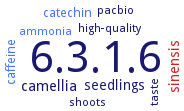6.3.1.6: glutamate-ethylamine ligase
This is an abbreviated version!
For detailed information about glutamate-ethylamine ligase, go to the full flat file.

Reaction
Synonyms
N5-Ethyl-L-glutamine synthetase, Synthetase, N5-ethylglutamine, Theanine synthetase
ECTree
Advanced search results
General Information
General Information on EC 6.3.1.6 - glutamate-ethylamine ligase
Please wait a moment until all data is loaded. This message will disappear when all data is loaded.
metabolism
physiological function
-
the flavor of tea is conferred by certain metabolites, especially L-theanine, in Camellia sinensis. More L-theanine accumulates in Camellia sinensis than in other plants. L-Glutamic acid, a precursor of L-theanine, is present in most plants, while ethylamine, another precursor of L-theanine, specifically accumulates in Camellia species, especially Camellia sinensis. Most plants contain the enzyme/gene, glutamate-ethylamine ligase, catalyzing the conversion of ethylamine and L-glutamic acid to L-theanine. After supplementation with [2H5]ethylamine, all the plants tested (Camellia nitidissima, Camellia japonica, Zea mays, Arabidopsis thaliana, and Solanum lycopersicum) produce [2H5]l-theanine, which suggests that ethylamine availability is the reason for the difference in L-theanine accumulation between Camellia sinensis and other plants
-
the enzyme is involved in theanine biosynthesis in tea plants. Theanine is the most abundant amino acid in tea seedlings
metabolism
DD410895
theanine synthetase is a key enzyme involved in theanine biosynthesis, theanine biosynthesis is derived from nitrogen metabolism in Camellia sinensis


 results (
results ( results (
results ( top
top






